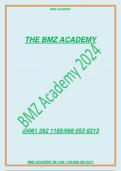BMZ ACADEMY
THE BMZ ACADEMY
@061 262 1185/068 053 8213
BMZ ACADEMY 061 262 1185/068 053 8213
, BMZ ACADEMY
Part A: Government Spending in South Africa
Introduction
Government spending plays a crucial role in fostering economic growth, ensuring
public welfare, and maintaining stability. However, excessive and unsustainable
government expenditure can create significant fiscal challenges, often termed a "fiscal
cliff." In South Africa, growing government expenditure has increasingly become
unsustainable due to multiple factors, including rising debt, inefficient use of resources,
and the challenges of financing through taxation. This essay explores the reasons
behind the growth of government spending in South Africa, its implications for fiscal
sustainability, and the consequences of financing rising expenditures through taxes.
Conceptual Framework of Theories
Government growth can be understood through various theoretical lenses, including
Wagner’s Law and Peacock-Wiseman Hypothesis:
Wagner's Law
Wagner (1893) posited that government expenditure tends to increase as economies
grow due to rising public demand for education, healthcare, and welfare services. In
South Africa, historical inequities have amplified this demand. For example,
substantial investments in social grants, education, and healthcare seek to address
disparities arising from apartheid policies (National Treasury, 2023). This theor
proposes that government activities and expenditure increase as an economy grows,
driven by public demand for infrastructure, education, healthcare, and welfare
services. In South Africa, these demands are further amplified by socio-economic
disparities and historical inequalities.
Peacock-Wiseman Hypothesis
BMZ ACADEMY 061 262 1185/068 053 8213Page 2 of 18
, BMZ ACADEMY
Peacock and Wiseman (1961) argued that public spending rises following social or
economic disruptions. South Africa’s transition to democracy and recent crises, such
as the COVID-19 pandemic, have led to significant increases in spending to address
unemployment, healthcare, and poverty (World Bank, 2021). The theory suggests that
public spending grows in response to social upheavals and economic shocks. South
Africa's political transition, coupled with the COVID-19 pandemic, has necessitated
increased government intervention, leading to sustained higher spending levels. South
Africa’s transition to democracy and efforts to redress apartheid-era disparities have
led to increased public spending on social services.
Keynesian Perspective
Keynes (1936) emphasized the role of government spending in stimulating demand
during economic downturns. South Africa has adopted this approach to mitigate
recessionary pressures, resulting in higher fiscal deficits (OECD, 2022). While such
measures aim to support economic recovery, they contribute to long-term fiscal
challenges. This theory argues for government spending as a driver of economic
activity during recessions. This perspective has influenced South Africa’s focus on
fiscal stimulus to address unemployment and economic stagnation.
Bureaucratic Theory
Bureaucracies tend to expand over time, seeking higher budgets irrespective of actual
needs. South Africa has seen significant increases in administrative and operational
costs, often critiqued for inefficiencies and corruption. Niskanen (1971) theorized that
bureaucrats, aiming to maximize budgets, often drive government expansion beyond
optimal levels. In South Africa, inefficiencies and corruption within public
administration contribute to bloated budgets. For example, maladministration in state-
owned enterprises (SOEs) like Eskom and Transnet has led to significant financial
burdens on the state (National Treasury, 2023).
Public Choice Theory
BMZ ACADEMY 061 262 1185/068 053 8213Page 3 of 18




